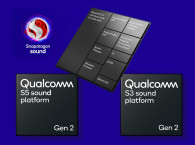One of my main goals for attending the Mobile World Congress 2024 in Barcelona - see my coverage here - was to leverage the opportunity to spend time with Qualcomm and ask questions about its Snapdragon Sound program, and the company's latest announcements.
For that purpose, I scheduled an interview with John Turner, Senior Director, Product Management Voice and Music at Qualcomm Technologies International, to learn more about the newly announced Qualcomm S7 Pro Platform (Qualcomm QCC7226 + QCP7321).
This is one of the most interesting solutions ever to come out of the former CSR team that currently leads the Snapdragon Sound efforts. The S7 Pro is the first integrated platform for true wireless earbuds that combines micro-power Wi-Fi connectivity and Bluetooth LE Audio, enabling seamless switching between both as required to maximize the user experience.

Before heading to Barcelona, I noted some questions we received following our original online post about the Qualcomm S7 Pro Snapdragon Audio platform. Most of those questions were related to the announcement about "micro-power Wi-Fi" connectivity, and how different that is from standard Wi-Fi. The second question on everyone's minds is how the switching between Bluetooth LE Audio and Wi-Fi takes place.
Now ready for the development of the next-generation TWS earbuds, this is undoubtedly an ingenious solution for wireless connectivity, which Qualcomm also intends to enable in home speakers and other audio products in the future. But for now, the technology will essentially break the bottleneck of audio quality for wireless headphones and true wireless earbuds, while at the same time, bringing to the market an interesting new platform for Bluetooth LE Audio and Auracast.

John Turner: Well, Wi-Fi has been around for a long time, but the application of Wi-Fi in headsets and earbuds, I think is very new. You know, the main barrier has always been power consumption. So, we've been working on some very low power Wi-Fi IP for quite a number of years. This is the culmination of many years of research looking for the next connectivity technology to take the headsets into a new era. And we looked at a few different options.
We looked obviously at Bluetooth. We're very aware of what's possible there. And the Bluetooth SIG has a long roadmap of innovations that they're going to bring into the spec over time. We looked at Wi-Fi, we looked at ultra wideband, and we even looked at other proprietary things...
We felt Wi-Fi offers basically the sweet spot of the kind of tools that we can use to really amp up the user experience. We get increased bandwidth that we can use for much higher audio quality. Because we're part of a network, we can now talk via a router back to the phone and get whole building coverage. And we get an IP address, which ultimately unleashes a brand-new set of user experiences that you don't get in a headset today.
aX: So, are we able to stream directly to devices? Something like Spotify Connect or Tidal Connect?
JT: Yeah. Ultimately, we can do that. I mean, what the right technology is to do the streaming, we're still working on that. But that's where XPAN comes in. Because from a user experience standpoint, we don't want the user to be aware that Wi-Fi was there. It's the same battery life and everything just becomes better. Suddenly the quality gets much better and we can go to very high-res lossless audio, rather than CD lossless today on Bluetooth.
We can also get much longer range so you can leave your phone and walk around the house. But the actual user experience from pairing, and the way the applications interact looks like Bluetooth. That was one of the key things that we wanted to achieve.
aX: The switching between Bluetooth and Wi-Fi is transparent to the user?
JT: Exactly. Underneath we switch between Bluetooth and Wi-Fi, and Wi-Fi direct from earbuds - from the phone to earbuds - to Wi-Fi via a router and back again, all based on link conditions, and based on the availability of Wi-Fi. If you're in your house connected via a router and you pick up your phone and walk out, it will still continue.
aX: That's another question. We connect to the home Wi-Fi - standard Wi-Fi 6, three bands, 2.4GHz, 5GHz, and 6GHz - but we need the streaming coming from the phone or a Snapdragon device, right?
JT: Yeah, that's right. The feature set at launch is that the application that's streaming the audio is running on the phone and then streaming to the headset, either directly or over the network.
aX: And to be scalable, we're talking about aptX encoding...
JT: That's right. The codec is based on a new version of aptX that we've developed...

JT: Yes. It's aptX Adaptive. It's not a new flavor, but as you know the app that takes Adaptive over Bluetooth only supports up to CD lossless. And now we're doing 96kHz, 24-bit lossless. So that's the update. And it's all backward compatible. Underneath it's the same technology.
When you mention things like Airplay or Spotify Connect, the innovations that we've done to help maintain the user experience don't really exist in those places necessarily. Because the one thing we try and avoid is audio glitching in a mobile environment, which means scaling the bit rate is really important.
We can think about a triangle between audio quality, latency, and link budget or link reliability. And we can't mess with the triangle. So, if we start getting link reliability problems, we need to be able to scale the quality down to avoid glitching.
And that technology is built into XPAN, where we can scale from a couple of hundred kilobits all the way up to many megabits without the user hearing any glitch. And if we didn't do that, as we would start getting interference, we would start hearing glitches. Especially if you're on a train - as in a train station in China, and everyone's got their mobile hotspots on. We take great care to manage that as well.
aX: In that scenario, are we connecting to a public Wi-Fi network?
JT: You don't have to. If you're streaming from your phone, we can do Wi-Fi direct to the phone. Smartphones today can connect to infrastructure and stream to the headset - they can do two Wi-Fi connections.
aX: Another aspect is latency. Is the switch as seamless as the audio codec?
JT: In the launch feature set we're still focusing on Bluetooth and LE Audio for low latency.
aX: Which is low, but it's not that low. That's the problem...
JT: Well, we've optimized the latency now down to about 38 milliseconds. From an application on Android, all the way through the Android stack and the mixer and then over Bluetooth, that's pretty good.
When we started on this journey, we were at about 80 milliseconds. And our developers were saying, "we might get you to 75..." And then we got to 65, then 60, and now we're at 38. So, we're approaching the limit of what's possible with Bluetooth at this point.
And some of the constraints are just around channel access at 2.4GHz. The advantages that we have with Wi-Fi are that we move to clear spectrum, and we get more bandwidth. Again, think of the triangle: as we reduce latency, if we want to maintain robustness, we have to compromise quality as well. We've still got some space for retransmissions when things go wrong. With Wi-Fi we've got much more bandwidth to begin with, so we can stream much higher quality audio at low latency.
I think this will really help with the gaming experience. That's what we're aiming for. And 38 milliseconds is on a phone. We've also got a USB dongle solution that is 20 milliseconds. And that's including a voice back channel as well to do game chat. That's a very robust solution.
We're watching latency quite a bit, but I think we're getting to the point where it's diminishing returns. The next battle could be to get better audio quality over that link.

JT: Yes, we use LE audio, and we use LC3 over Bluetooth, which is isochronous in nature. That kind of really helps. But we've still got to leave time for retransmissions. There's a lot of things we add on top of LC3 around packet loss concealments, and other things to minimize the time window we leave for retransmissions and keep that latency down.
aX: How does that approach conform to the LE Audio specification? That's a question we're getting a lot from ODMs. Or doesn't that matter?
JT: Yeah, that's a good question. The way I think about it is in layers. At the core, we support fully standards-based LE audio - as we did with Bluetooth Classic. If we've got Qualcomm on both ends, Snapdragon Sound uses LE audio underneath. We support Qualcomm High Speed (QHS) under LE Audio today, which works when we've got our chips on both sides.
And that same paradigm works when we've got XPAN on both sides. If both sides support XPAN, we'll move to micro-power Wi-Fi. It's just those layers.
But there'll be tiers in the market. Wi-Fi is aiming at the kind of higher-end, premium market. And we're still going to be supporting LE audio-based, but with our proprietary extensions in the mid-range as well.

JT: LE Audio is much more flexible than A2DP was in terms of how you configure it. We effectively configure topologies and endpoints. So yeah, there are situations where people have different ideas on how to configure the link, even in simple things like two earbuds. Do I have two separate connections, one to each, or do I have a kind of stereo to both?
And this also impacts things like being able to support spatial audio technologies in earbuds. Because if both earbuds are only receiving mono, then we can't run some of those spatial audio algorithms.
Again, we're working with the SIG to address that and get stereo to both. That's an early change that's happening.
I mean, we're in a great position here. Because we work with phone manufacturers, we have great partners for testing and interoperability...
We were very early to market with LE Audio, and we are quite a way ahead of a lot of our competitors with a very stable solution. And the feedback we see from customers in the "unplugged fests" is that it's very interoperable. Some of our competitors still have some interop problems that need to be ironed out in the industry.
But that's normal for any standards introduction...

JT: Auracast is great. I mean, the promise is there. There's obviously the network effect of having enough phones and headsets that can support it to drive the demand for the infrastructure. So, we end up in this "chicken and egg" situation because you need all three pieces to do the infrastructure for Auracast.
The use is quite exciting, but we need to be able to discover the stream with a UI on the phone and be able to receive it and transmit it...
And that's what we did with the Bluetooth SIG Auracast Experience - we actually put some code in our headset. It's the headset that does the scans for the streams that are available and then passes the list back to your phone. The phone doesn't need to natively support Auracast, which makes the whole thing so much easier to deploy. We don't need a new phone or a new chip, and I think that will help accelerate it.
aX: The S7 platform also offers a whole lot more, including in terms of DSP to support ANC...
JT: On the S7 itself, we've doubled down on two main areas. One is the complexity of the filters.
ANC is just all about creating anti-noise based on input from microphones on the inside and the outside of the ear. To do that, you're basically chaining together, in quite complex ways, a quantity of filters.
The other piece is latency. So, there's this balance between complexity of how many filters you want to support and the latency, because obviously if your latency is too long, you miss the anti-noise window. In the S7 we've got an incredibly low latency system of filters that can be tuned by customers. We can support adaptive ANC and switch filters in and out as needed based on fit changes, or as the fit moves around and more audio leaks in from the outside - we need to adapt the filters and the gain and so on.
That's one piece of it.
The other piece that's quite new is more around hearing augmentation. So sound amplification. Again, think of it as a developer's platform. We've got a very low latency DSP where developers can go and implement hearing augmentation algorithms without getting the comb filter problem.
Because again, if the latency is too long, you get these weird artifacts. And then with the ML core that we've got and the bigger DSPs, the market's going to move to real-time adaptive and behavioral adaptive. Being able to very accurately understand when the user is in a conversation with somebody and when that conversation ends- the solutions that do that today tend to turn ANC back on very quickly. Instead, being able to turn on transparency mode, understand the audio scene around the user and adapt to let in certain sounds.
I think we're going to see a lot more of that in the future. And that's more about code running around ANC and adapting the filters.
aX: Are you offering a software interface to deal with those?
JT: We provide a full software developer experience. We call it the ADK. It effectively includes an operating system on the chip and all the developer tools. Part of that is focused on ANC to do a tuning and then development of the algorithms that adapt to the ANC in real time.
We have tuning tools that run on a PC, where you can design filters and apply those, building up audio chains. We work with Audio Weaver as well.

aX: We discussed earbuds so far. But the S7 announcement also mentions speakers. Is it the same chip? From a speaker we don't necessarily need to have a smartphone in the equation if I'm using Wi-Fi...
JT: From a speaker standpoint, yeah, it's the same platform. XPAN will still play in speakers. But because speakers are a static thing in a room and the antennas are more manageable, at that point we can look at more things like having more of a smart speaker experience on this type of chip.
A lot of the smart speaker software that exists today is based on Linux and we're an RTOS chip. So, we're exploring how we bridge that gap, but there are RTOS implementations for that.
aX: That's still in the works?
JT: Yeah, that's a future thing at the moment. We're focused very much on XPAN, of course. That's a huge thing!
aX: At this show you've also announced the Fast Connect 7900 solution, that does UWB as well for object finding, indoor navigation, and applications like that. Are you considering UWB as another option for streaming audio?
JT: Not at the present. Again, I have to look at what UWB brings to the mix. If all you want to do is have a dongle in a TV or a gaming console and sit a couple of meters away from the gaming console, UWB can achieve that, but so can Wi-Fi.
And Wi-Fi comes with all these other benefits.
In the analysis we've done, doing UWB streaming from a phone to earbuds runs into problems if you've got the phone in the back pocket and your earbuds in - you start getting fading and dropouts. It's not as robust as Wi-Fi for the kind of link budget that you can get.
It's something we're monitoring, but we think there are other ways to achieve the same benefits and bring a whole set of other things as well. aX
This article was originally published in The Audio Voice newsletter, (#460), March 14, 2024.







